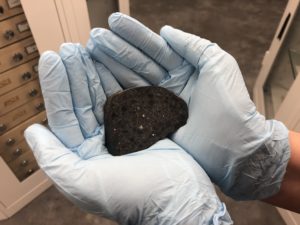Water on Mars
Center Assistant Research Scientist Dr. Jemma Davidson is lead author of a new paper on Mars' water, published in the journal Earth and Planetary Science Letters.
Davidson’s recent work involves tracing magmatic volatiles, specifically hydrogen, in minerals in meteorites and terrestrial analogues to learn about how the terrestrial planets gained their water.

In this new paper, Davidson and her ASU School of Earth & Space Exploration co-authors present the results of coordinated hydrogen isotope and water content analyses of phosphate grains from the martian polymict breccia meteorite Northwest Africa 7034 (aka Black Beauty). The study provides insight into the complex history of the martian crust, including impact and magmatic processes, and crustal fluid exchange.
Constraining the abundances and isotopic compositions of volatile elements on Mars is key to understanding the origin of Mars’ water and the evolution of its mantle, crust, hydrosphere, and atmosphere,” says Davidson. “Studying hydrogen is crucial to understanding how planets and moons evolve and to determining how the terrestrial planets gained their water.
The study focuses on Northwest Africa (NWA) 7034 from the ASU Center for Meteorite Studies collection, which is one of the most important meteorites discovered in the last decade. Indeed, NWA 7034 and its paired meteorites more closely resemble the composition of the martian crust than any other meteorite found to date.
Northwest Africa 7034 is an extremely important meteorite because it gives us a way to investigate Mars’ crust in the lab,” says Davidson. “Until robotic missions return samples from Mars in the coming decades, martian meteorites continue to provide the only way for us to get our hands on the Red Planet.
Dr. Davidson works in collaboration with SESE Director Prof. Meenakshi Wadhwa; they were recently awarded a NASA Solar System Workings grant to apply their studies of volatiles to lunar meteorites and samples returned by the Apollo missions. This work will aim to further our understanding of the source and evolution of water in the Moon and the terrestrial planets.
Learn more about Dr. Davidson's research, here!